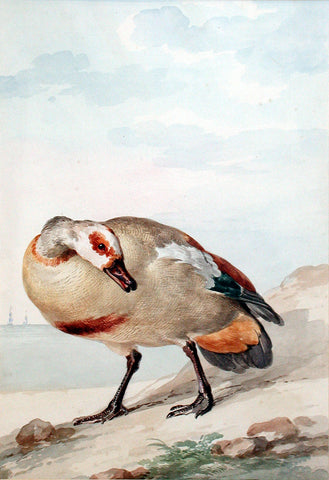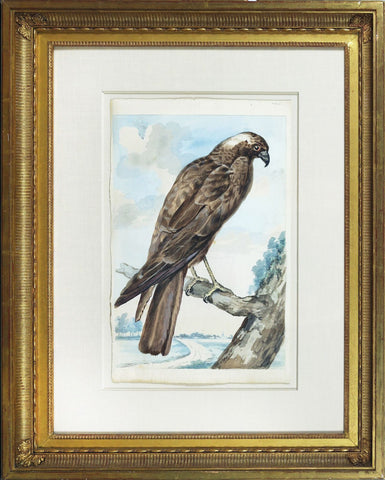
Aert Schouman (Dutch, 1710-1792), An Egyptian Goose on the Shore
Aert Schouman (Dutch, 1710-1792)
An Egyptian Goose on the Shore
Black chalk, watercolor, pen and ink framing lines; watermark: Strasburg lily
Inscribed verso: Een Kaapse Berg gans, circa half levens grootte A: S: 1756/Een Kaapse Berg Gans, nog niet half levens groot. A.S. 1756
Inscribed on mount: GT 320 and Kaapsche Berg Gans/half levensgroot and A Schouman 1756
Provenance: Property of a European family trust
Paper size: 14 3/8 x 9 7/8 in.
Frame size: 25 1/2 x 21 1/8 in.
Aert Schouman was a prolific artist who specialized in flower painting and engraving on glass but was foremost in natural history painting. After training with F. Greenwood and Adriaen van den Burg, he became a master painter at The Hague in 1748, and three years later, regent of the art academy. By 1762 he had been appointed principal of the academy and included among his pupils the great Dutch flower painter Jan van Os.
Schouman was fortunate to receive royal patronage and completed many works for Prince Willem V at the summer palace of Het Loo, at Apeldoorn. The Prince owned a zoological cabinet and a menagerie that contained mammals, snakes, and birds from various parts of the world. However, the eighteenth century’s favorite bird subjects were still live domestic poultry, followed by dead partridges. New breeds were developed among the domestic birds and pyle, hamburg and bantam cocks began to appear. Compositions featuring hens with their chickens were very popular. Interestingly, imagery of the young of almost every other species (except for ducklings and goslings) were ignored.
Between 1765 and 1768, Schouman was employed in the animals’ pictorial recording at Willem V’s palace at Het Loo. Over one hundred drawings by him can be found in one of the few surviving complete recueils, the Vogel Broeck (the Bird Book). Moreover, Schouman’s depictions of the animals housed in the royal menagerie and those of Simon Fokke, formed the core of thirty-four treatises on foreign animals, published between 1767 and 1787 by Arnout Vosmaer. Descriptions written by Peter Simon Pallas accompanied Their illustrations. In these beautiful watercolors, the full range of Schouman’s skill is evident. He forges a remarkable synthesis between a concern for scientific truth and the decorative and exotic aspects of natural history that were highly prized by royal and private clients. In his ornithological presentations, Schouman places the bird in a setting that provides an impression of scale.
or by email at loricohen@aradergalleries.
We Also Recommend





